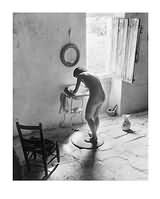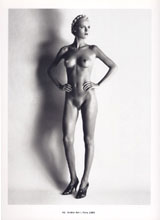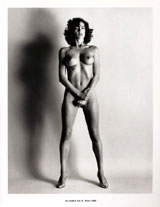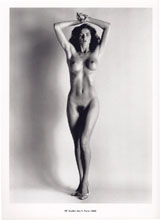
photography, writing, fine art... stuff ... other stuff ...
A simple image of a naked woman washing herself. The woman, alone; the activity, reflexive.
The surroundings simple, ordinary, peaceful. The image, with its implied narrative, has become
for me an archetype of the domestic. And in the course of my meditations on the theme, the word
domestic has become increasingly problematic.
For instance, a literature search on the word 'violence' ... an attempt to understand the domestic
in contrast with the 'agonistic' which seemed initially to be a polar opposite, throws up more
titles on 'domestic violence' than on any other theme (and this was not a slight thing ... titles
including the phrases 'domestic violence' or, 'intimate violence' accounted for a large percentage
of the listing; the issue was far more prominent than any of the many other aspects of violence to
have preoccupied academics across a range of disciplines).
Sidelining for a moment the issue of coercion, the domestic problematic remains. At the end of
the day, the range of activities which a person can practice naked in the privacy of their own
home is virtually limitless. They include the erotic and the non-erotic. Play, erotic or otherwise, can
incorporate a wide range of physical positions and supporting props. Traditional private activities such
as washing, sleeping, and the enjoyment of sex, are commonly practised naked, and many other domestic
activities such as preparing food, watching television, can be practised naked without anyone raising
an eyebrow. Some activities may present particular hazards when naked (hot fat) while in other cases
nakedness may offer particular advantages ... physical exercise, some forms of religious meditation ...
If Ronis simply showed a woman carrying out some everday activity 'as if' the photographer simply
weren't there, or as if he had simply happened upon the scene, then a modern translation of the situation
might just as easily have the photographer happen on a couple privately filming themselves acting out a scene
of extreme sado-masochism where acts of violence (allowing for a liberal notion of 'consent') might
occur .... blood might be shed, and permanent scarring might result. Faces might be
contorted in fear, excitement or pain.
In part this reflects a change in the publicly acknowledged awareness of the extremes to which
private choices often take people. We now allow freely that the domestic sphere includes a freely
individualised sexuality. When Ronis took the picture, although the domestic sphere was almost certainly
no less extremely individualised, public consent or acknowledgement was withheld.
In part, however, this reflects Ronis' choice. There is no reason to believe that the woman portrayed was not
at the time enjoying a satisfying sex life. Ronis could, presumably, have shown her at the moment of orgasm,
either with a partner or masturbating alone. We know nothing of the events preceding the moment when she is
portrayed: perhaps she is washing herself after sex. But Ronis has chosen to show her in a neutral context.
Or she has chosen to show herself to Ronis in that way. Or those other pictures, if they do exist, have never
been published (that is, they remain in the private sphere).
In this context, I am reminded of the process of writing a novel,
Zaire, in which the main
storyline was set against a background of violence and deceit. The protagonists moved in a world where
almost every word or action carried a subtext in which threat or danger was communicated. In such a
world, I searched for moments of innocence, where, if possible, there was no subtext, or where the
subtext spoke of normality, or of simple humanity. I found these moments in the simple everyday
activities of, for instance, preparing a meal, or washing. Although even there, the potential always
exists for a menacing subtext ... a kettle of boiling water becomes a means to do harm, a knife that
peels vegetables can become a weapon, a body is an intrinsically vulnerable thing. Andrea Dworkin records
a similar problem:
The photographs I had to study changed my whole relationship to the physical world in which I live.
For me, a telephone became a dildo, the telephone wire an instrument of bondage; a hair dryer became a
dildo - those hairdryers euphemistically named 'pistols'; scissors were no longer associated with cutting
paper but were poised at the vagina's opening. I saw so many photographs of common household objects being
used as sexual weapons against women that i despaired of ever returning to my once simple ideas of function.
Dworkin, A. Pornography: Men possessing women, London, Women's Press. p. 303.
What this demonstrates, I believe, is that it is ultimately a human decision which identifies the
domestic. That decision, rooted in a sense of privacy which may be 'human' (i.e. not culturally
determined) at the most fundamental and universal level, is one which all societies recognise. At
whatever point we draw the line, we all have our own sense of personal space, and we all have aspects
of our lives which we choose not to share with others, or with only a very limited number of people.
What Ronis and his wife have done, then, is to take a relatively private moment, although not the most
private of moments, presenting it for a public (perhaps not for everyone .... 'art' is to some degree
self-censoring, even if only by virtue of the boredom it engenders in such a large proportion of the
general population).
And central to this choice of moment, I believe, is the avoidance of any directly sexual
or erotic reference. In so far as the image conveys sexuality or eroticism, that happens
as a result of the simple fact of a young woman's body and its conformity to traditional notions
of what is 'healthy', or 'natural', or 'beautiful'.
So, for instance, we can see in the image clear echoes of traditional images of nudity. The figure
stands contraposto, unadorned, and with clear classical overtones. There is no direct connotation of the
tradition that shows the naked female as an embodiment of fertility ... there is nothing here, for instance,
of the Venus of Willendorf. Nothing about the body
is exaggerated or emphasised, bearing in mind the cultural norms of Europe in the mid 20th century. It is possible,
however, to find parallels with many images central to the Western tradition: Rembrandt's Bathsheba, or Hendrickje
bathing, for instance. Or the pastels of Degas. And these images themselves have contexts which are not simply
domestic. They portray goddesses .... female figures of destructive potential, or they portray episodes in
dramatic narratives, as the story of David and Bathsheba,
which have long-reaching and violent consequences.
The woman's activity itself, however, is a human universal, as basic as sleep or sex. These three are also the
activities one might, in many cultures (and certainly 20th century Western culture) most expect to be typically
practised naked by a large proportion of the population.
The woman is apparently alone; although we know that the photographer is present, she shows no sign of
awareness that he is there. In fact, it would have been technically a very simple matter for Ronis to set
up the camera on a tripod with a delayed shutter release and leave the room. It is the camera which is the
human presence, the anonymous viewer with whom the woman has no relationship. Not only the eye contact is
absent which was for many years a traditional indicator of 'glamour' or 'pornographic' as opposed to 'artistic'
imagery: any sense of deliberate display is equally absent. There is no attempt to use pose, gesture, or
props to abstract the figure from either its physical context or the context of everyday activity. Of
course, the woman is aware that she is being observed, and it is possible, if not likely, that the pose
has been chosen with conscious awareness of that. If not conscious, then it is almost inevitable that
unconsciously the woman has adjusted her body, at the very least to avoid an appearance of awkwardness.
The degree to which earlier images have influenced the model or photographer is something which almost
certainly neither could, even at the time, have been fully aware of.
Supporting this air of normality is the context of the figure. The room in which
she is washing herself has very little furniture. There is a wooden chair which, like the wooden
shutters at the unglazed window, is rustic in its simplicity. She washes herself in a simple basin
supported on an iron stand. There is a simple grace in the bowl and stand which rises above brute
functionality but which carries no connotation of luxury. The floor is of simple tiles, made of
some unpolished material, perhaps stone, perhaps terracotta.
The woman occupies a relatively small proportion of the whole image, much less than 10%. In an image of
portrait format, showing her full figure, her height is well under half that of the height of the
image. To add a personal note, the longer I look at the image (and attempt to translate it into a modern
context) the more I am impressed by the composition, and in particular by the interplay between the figure
and its surroundings. Almost every time, on returning to the image, I find myself surprised to find how
small the figure appears. A range of traditional compositional devices lead the viewer to the image - it's
semi-silhouetted tonality against a light background, the presence of the mirror above the washbasin,
lines of light and dark leading back across the figure to the window which is the only light source. And
all this is done in a beautifully understated way, making the figure more prominent and memorable, while
letting all these elements contribute their own symbolism, in particular strengthening the overall note
of simplicity and naturalness.
It is a beautiful image - a restful image. The circumstances of its making (Marie-Anne refreshing
herself after waking from a siesta) have clearly coloured the image itself ... perhaps still influencing
the figure's muscle tone, for example. And yet there is no such thing as a simple image of a naked woman.
That is, unless the viewer can exclude everything he or she already knows about the world.

|

|

|
Everything which we have identified in the Ronis image as central to its domesticity is absent
from the Newton Big Nudes.
The Newton Nudes are clearly studio shots. The background is a standard paper-roll designed to eliminate
background distraction so completely that even the junction between walll and floor disappears into the paper's
gradual, natural curve.
The women are naked, except for high-heeled shoes. The shoes serve a number of roles. Firstly, they affect
the model's stance. They change the balance of the whole figure, raising it's centre of gravity, and requiring
a response in the musculature of almost the whole body. It is impossible not to 'pose'. Visually, the legs are
lengthened and thereby emphasised, as well as having their lines adjusted to a more 'elegant' shape. The result
is, visually, that the legs serve more directly as a pointer to the sex. Symbolically, the shoes represent
'culture', the conscious organisation of the body and its orientation towards a social context. That social
context (as we know from the images' context in the overall range of Newton's work) is the world of wealthy
Westerners. More directly, they are 'fuck me' shoes, and the characteristic footware either of fashion models or
strippers. They represent the intention of sexual display. And all this in a world where sexual display and the
display of wealth or power are virtually indistinguishable.
The bodies themselves represent modern ideals. They are athletic, with good muscle definition and an absence
of 'surplus' fat. They are also carefully presented; make-up and hair styling are immaculate, with
hard-edged hair lines and strong contrasts between skin tones on the one hand and lip or eye lines on the other.
The poses are frontal and confrontational. The models are not simply aware of the viewer's presence, they are
challenging that presence. The range of reactions which we might easily associate with observed nakedness is
virtually limitless, but certainly reactions such as fear, shame, anxiety or embarrassment are completely absent.
In some of the images the sense of challenge extends to traditional gestures of defiance, raised arms or clenched
fists. Whether the potential for violence is in response to a perceived threat, or itself a first threat is impossible
to know. Clearly, however, the potential for violence is there. It is for this reason that I find it appropriate
to think of them as 'agonistic'. I also like, however, the 'martial' characterisation of Newton's women provided
by Gunter Sachs in an interview with Spiegel:
ich würde Frauen nicht wie Helmut Newton als martialische Sex-Walküren zeigen
http://www.gunter-sachs.de/astrologie/deutsch/pressespiegel.html
It is traditionally said of Newton that he portrays women as 'strong'. In German, Newton's first language,
strong is 'stark', and this 'stark' quality is unavoidable even when trying to read the images within a purely
Anglophile tradition. There is nothing here, however, of the 'stark naked' ... a phrase in English which, while
hard to pin down, does include the connotation of 'nothing but naked'. These are, to use Angela Carter's phrase,
'Sadeian Women', women who use their sexuality as a weapon. In this sense, of course, they represent a long tradition
of femmes fatales, and point back to the classical conception of the woman as a sublime presence, capable of
destructive, violent acts. To use a relatively dated part of the vocabulary of popular Western culture, these
are 'devil women', or 'she-tigers', Ayeshas or dominas. And they adopt these animalistic, confrontational roles
by choice. (Apparently, although we know that in fact it is Newton's male choice, and that he, more than almost
any other contemporary photographer, regards the model as his object to direct, and as being there to do as he
says regardless of how this suits her own image of herself).
In the interpretation of posture and gesture, however, it is easy to drift into ambiguities. The poses are
Newton's choice, the sexual roles which the women adopt reflect his male regard, but they are clearly also
postures and roles which many women freely choose for themselves. Power-exchange is a game which attracts both
sexes, and which attracts both heterosexual and homosexual couples. It is not necessary to go as far as Andrea
Dworkin, who asserts that all sex is rape, in order to recognise that issues of capture, or of 'forcefulness' are
fundamental if not intrinsic to human sexuality.
What is clear then, in Newton's Big Nudes, is that nakedness as sexual, and sexuality as having to do
with confrontation and force, is being emphasised. If in this sense Newton is showing us something of our
animal nature, or something which is universally human, then he is subverting the very symbols of culture
on which his images so strongly depend. In eliminating the everday context (by the use of studio backgrounds)
and in using the trappings of apparently sophisiticated, wealthy social contexts from the world's more 'developed'
cultures, Newton is emphasising precisely that basic biological animality which Western traditions have for so
many centuries attempted to elide. Since 1859 the West has progressively moved the biological basis of human existence
into the centre of its understanding of the human condition. Nevertheless, as Newton himself has often
shown (particularly in his 1986 photograph of 'Fat Hand and Dollars') culture constantly attempts to
assert itself over against nature.
Although Newton has long been discussed in the context of feminism and gender politics, it strikes
me that these issues are actually peripheral to his work. Much of it, in fact, is more directly about
money than it is about sex. It is, in other words, about the world in which the naked figure is always
located, regardless of the consciousness of the model, the photographer, or the viewer.
Harry Smart, May 2003